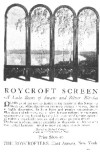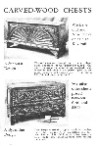


The depression took its toll at the Roycroft, as it did elsewhere. Attempts were made to accommodate changing public taste, which reflected, in part, a desire to escape the tedium of harsh economic times. The July, 1930 issue of the Roycrofter magazine offered a four-panel Roycroft room screen painted by Richard Krueger and set into an oak frame carved by Charles S. Hall. The screen depicted white swans and silver birches reflected in the water and set off by autumn leaves. It is reminiscent of the type of decoration that had become so popular in the exotic movie palaces of the period; although it appealed to the popular taste, only the wealthy could have afforded its price of $800.00. This provides a clue as to what his carvings could be worth today.

Both upper and middle classes were the objects of a new advertising campaign. The October 1930 issue of the Roycrofter offered two chests for sale. The advertising copy stated that:
This old chest was brought in, in rather dilapidated condition. It was painted red, and it was much the worse for wear, but we repaired it and carved it until now it's a perfect gem of the cabinetmaker's and carver's art. It is priced at $85.00 and there is but one!...[The design of the other chest] is strictly original but it is a rendering of the Byzantine Style—an ecclesiastical pattern. The wood is old pine, with hand-wrought nails, made before machine-made nails became the vogue!This departure from the sparce style that had characterized Roycroft furniture, along with the concept of reworking old pieces, was a far cry from Hubbard's original Arts and Crafts philosophy. Realistically speaking, the Furniture Shop and the mission aesthetic had run their course. People longed for the "good old days" and looked for direction from Wallace Nutting, who stressed the designs of the colonial past. The result, in the case of the carved chests, was a compromise, using "country" antiques that had been "refinished" by the Roycrofters, thus combining early American design with the esteem of the well-known craftsmen.

Seen in the Roycroft Gift Shop (the original blacksmith / copper shop built in 1902), in a room devoted to Roycroft antiques, was a three-panel room screen similar to the four-panel screen described above. This screen was also adorned with a Richard Kruger painting. The frame appeared to be carved from wood softer than oak but its dark red brown stain masked its true identity. The upper scroll work as well as the lower detail can be seen in these close-up photos. This same screen is pictured in Robert Rust and Kitty Turgeon's book, Images of America--The Roycroft Campus. Shown on page 26, we see a photograph taken in 1977 with four generations of Hubbard women seated in and surrounding a chair in the William Morris Room of the Roycroft Inn. In the background is the same three-panel screen. The caption under the photo states:, "In this 1977 view, four generations of Hubbard women pose in the William Morris Room of the Roycroft Inn. Miriam Hubbard Roelofs, the daughter of Elbert and Alice is seated. On the right is Nancy Hubbard Brady, the granddaughter of Elbert and Bertha. Also pictured are her daughter Linda and her children, Cindy (left) and Kelly Lynn Falkosky (front right)."